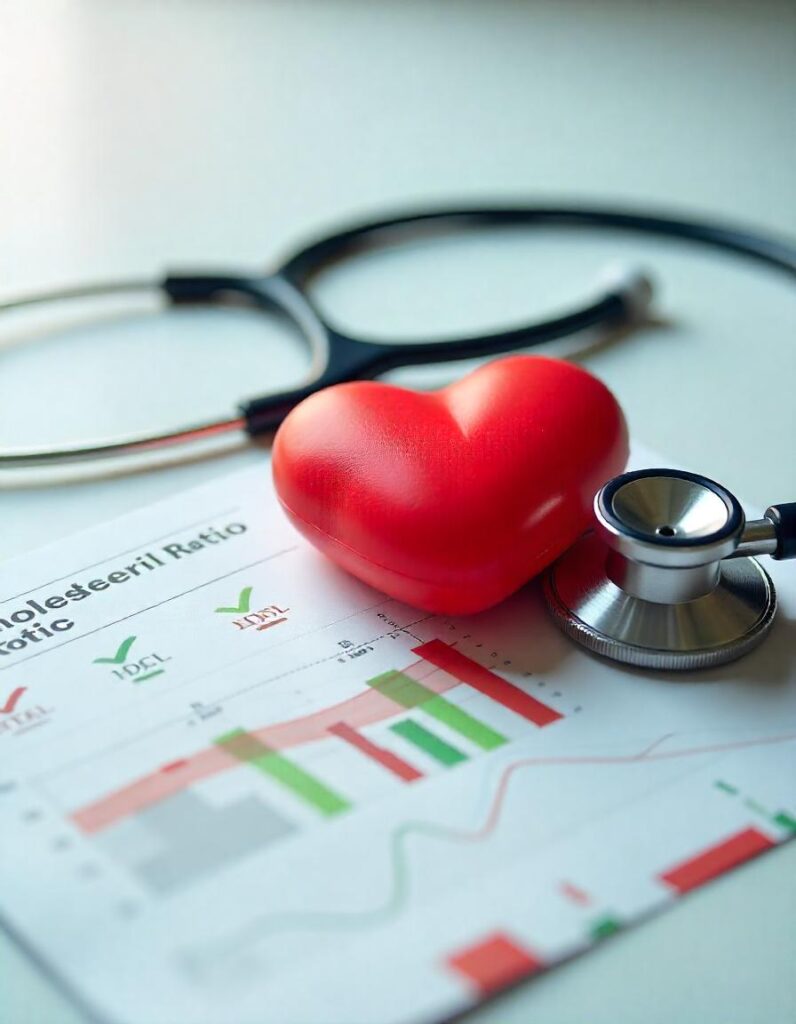Cholesterol Ratio Calculator
Your Cholesterol Ratio:
Interpretation: The cholesterol ratio is calculated by dividing your total cholesterol by your HDL level. A lower ratio indicates a lower risk of heart disease.
Heart Health Recommendations
Find out how to calculate your cholesterol ratio with our comprehensive guide. Learn about HDL, triglycerides, and the correct cholesterol/HDL ratio for heart health.
Introduction to Cholesterol Ratios
What is Cholesterol?
Cholesterol is a fatty substance that your body needs to function properly. It plays a critical role in building healthy cells, but too much cholesterol can increase your risk of heart disease. Cholesterol travels through your bloodstream attached to proteins called lipoproteins. There are different types of cholesterol, mainly HDL (high-density lipoprotein) and LDL (low-density lipoprotein), which are both crucial in maintaining a balance for heart health.
Why is Cholesterol Important for Your Health?
Your body needs cholesterol for producing essential hormones, vitamin D, and bile acids that help in digestion. But when cholesterol levels become unbalanced, it can lead to a build-up of plaque in your arteries, causing them to narrow, and eventually leading to heart disease. That's why understanding your cholesterol ratio is essential in assessing your heart health.
Understanding Cholesterol Ratios

The cholesterol ratio refers to the ratio between total cholesterol (TC) and HDL cholesterol in your blood. This ratio is one of the key markers doctors use to predict heart disease risk.
Cholesterol and Lipid Profile Explained
What Does a Lipid Profile Test Measure?
A lipid profile test is a blood test that measures the levels of cholesterol and triglycerides in your blood. It gives you a comprehensive view of your heart health by checking:
- Total Cholesterol (TC)
- Low-Density Lipoprotein (LDL) - "Bad Cholesterol"
- High-Density Lipoprotein (HDL) - "Good Cholesterol"
- Triglycerides (TG)
These numbers help healthcare providers assess your risk of heart disease and stroke. Regular testing can be a vital tool for early detection and prevention.
The Role of LDL, HDL, and Triglycerides in Heart Health
Understanding the roles of LDL, HDL, and triglycerides is crucial for maintaining heart health:
- LDL is the "bad" cholesterol because it can build up on the walls of your arteries, leading to plaque formation, which narrows and blocks blood flow.
- HDL, on the other hand, is the "good" cholesterol. It helps remove LDL from the bloodstream, carrying it back to the liver where it's processed and removed from the body.
- Triglycerides are another form of fat in the blood. High triglyceride levels can increase the risk of heart disease, especially when coupled with high LDL or low HDL levels.
Cholesterol Levels: What Do They Mean?
Your cholesterol levels are broken down into different categories:
- Total Cholesterol: Ideally, you want this number to be below 200 mg/dL.
- LDL Cholesterol: A level below 100 mg/dL is considered optimal.
- HDL Cholesterol: For men, a level of 40 mg/dL or higher is desirable; for women, it should be 50 mg/dL or higher.
- Triglycerides: Less than 150 mg/dL is considered normal.

The overall health of your arteries is impacted by how well these numbers balance each other out. High LDL and triglycerides with low HDL can significantly raise the risk of heart disease.
How to Calculate Cholesterol Ratios
Cholesterol/HDL Ratio Formula
The cholesterol-to-HDL ratio is calculated using the following formula:
- Cholesterol/HDL Ratio = Total Cholesterol / HDL Cholesterol
This ratio helps to evaluate the proportion of "bad" cholesterol (total cholesterol) to "good" cholesterol (HDL). Lower ratios are better as they indicate a higher level of HDL relative to total cholesterol.
TC/HDL Ratio: Why It Matters for Your Heart Health
The total cholesterol-to-HDL ratio provides insight into the overall cardiovascular risk. A lower ratio indicates a better heart health profile, as more HDL is present to counterbalance the harmful effects of LDL. Ideally, this ratio should be below 4.5:1 for the general population.
How to Calculate Your Cholesterol Ratio
To calculate your cholesterol ratio, simply divide your total cholesterol by your HDL cholesterol. For example:
- If your total cholesterol is 200 mg/dL and your HDL is 50 mg/dL, your cholesterol/HDL ratio would be:
- 200 ÷ 50 = 4.0
This is a healthy ratio, as it’s under the recommended 4.5:1.
What is an Ideal Cholesterol Ratio?
Recommended Cholesterol/HDL Ratios for Healthy Adults
Health experts generally recommend the following cholesterol-to-HDL ratio ranges for adults:
- Ideal Ratio: Less than 3.5:1
- Acceptable Ratio: 3.5:1 to 5.0:1
- High Risk: Above 5.0:1
A ratio above 5.0 indicates a higher risk of cardiovascular diseases, such as heart attacks or strokes. It’s important to maintain a healthy ratio through diet, exercise, and, when necessary, medication.
Interpreting Your Cholesterol Ratios

If your cholesterol ratio is high, it might indicate that you're at risk of cardiovascular problems. High cholesterol levels in combination with low HDL (the "good" cholesterol) can be detrimental to heart health. If you're unsure about your numbers, consult your doctor for further testing and advice.
Cholesterol Ratio and Heart Disease Risk
High Cholesterol and Its Effects on Your Health
High cholesterol levels can lead to atherosclerosis, where plaque builds up inside the arteries, limiting blood flow and increasing the risk of heart disease. High levels of LDL and triglycerides contribute to this condition, making it crucial to manage cholesterol levels for heart health.
The Link Between Cholesterol Ratios and Cardiovascular Diseases
A higher cholesterol ratio (especially with low HDL and high LDL) significantly increases the likelihood of developing cardiovascular diseases. Researchers have found that people with higher ratios tend to have more plaque buildup in the arteries, which can eventually lead to heart attacks and strokes.
Managing Cholesterol Levels for Better Health
Managing cholesterol ratios involves dietary adjustments, regular physical activity, and in some cases, medications like statins to lower LDL cholesterol levels and boost HDL levels. Quitting smoking, maintaining a healthy weight, and reducing alcohol intake can also significantly impact your cholesterol levels.
Common Myths and Misunderstandings About Cholesterol
Cholesterol and Dietary Fat
A common myth is that dietary fat directly contributes to high cholesterol levels. While certain types of fat (like trans fats and saturated fats) can raise LDL cholesterol, others, like unsaturated fats, can actually help lower LDL levels and raise HDL levels. Moderation is key.
Are Statins the Only Solution for High Cholesterol?
Statins are widely prescribed to lower cholesterol, but they're not the only solution. Lifestyle changes, such as increasing physical activity and consuming heart-healthy foods, can also have a significant impact on cholesterol levels. It's best to explore a combination of options in consultation with a healthcare professional.
How to Improve Your Cholesterol Ratios Naturally
Foods That Help Improve Cholesterol Levels
Certain foods can naturally help improve your cholesterol ratio:
- Oats: Rich in soluble fiber, oats can help lower LDL levels.
- Fatty Fish: Omega-3 fatty acids found in fish like salmon and mackerel can lower triglyceride levels.
- Avocados: These are full of healthy fats and can increase HDL levels.
- Nuts: Walnuts and almonds are heart-healthy and can lower LDL levels.
- Olive Oil: A source of healthy fat, olive oil can help lower bad cholesterol and raise good cholesterol.
The Role of Exercise in Cholesterol Management
Exercise plays a crucial role in improving your cholesterol ratios. Aerobic exercises like walking, jogging, swimming, and cycling can help increase HDL levels and reduce LDL levels. Aim for at least 30 minutes of moderate exercise on most days of the week.
Lifestyle Changes to Improve Your Cholesterol Ratios

Aside from diet and exercise, other lifestyle changes can help manage cholesterol levels:
- Quit Smoking: Smoking lowers HDL cholesterol and raises LDL levels.
- Limit Alcohol: Excessive drinking can raise triglyceride levels and contribute to higher cholesterol.
- Maintain a Healthy Weight: Losing excess weight can help lower LDL and triglycerides, improving overall cholesterol ratios.
Advanced Cholesterol Testing: Beyond the Basics
What Are Non-HDL Cholesterol and ApoB?
Non-HDL cholesterol is the total cholesterol minus the HDL. This measure includes all of the "bad" cholesterol and is considered an important marker for cardiovascular risk. ApoB is a protein found in all atherogenic lipoproteins (particles that can contribute to plaque buildup). Higher ApoB levels are associated with increased cardiovascular risk.
Understanding Particle Size and Cholesterol Testing
Cholesterol tests can also assess the size of your cholesterol particles. Smaller, denser LDL particles are more likely to cause plaque buildup, while larger particles are considered less harmful. Advanced testing can provide a more detailed view of your cardiovascular risk.
Frequently Asked Questions (FAQs)
How Often Should You Check Your Cholesterol?
Adults should have their cholesterol checked every 4-6 years. If you're at risk for heart disease or have high cholesterol, your doctor may recommend more frequent testing.
Can Cholesterol Levels Change Quickly?
Yes, cholesterol levels can fluctuate depending on diet, exercise, and lifestyle changes. A quick improvement can be seen with positive changes, while poor habits can lead to a rise in cholesterol over time.
What If My Cholesterol Ratio Is High?
If your cholesterol ratio is high, it's important to work with your doctor to assess your heart disease risk and create a plan to lower your ratio. This might include dietary changes, increased physical activity, and possibly medication.
What Foods Should I Avoid to Lower Cholesterol?
Avoid foods high in trans fats and saturated fats, such as fried foods, fatty cuts of meat, and processed snacks. Focus on healthy fats like those found in fish, nuts, and olive oil.
Can I Lower My Cholesterol Without Medication?
Yes, cholesterol can often be lowered through diet, exercise, and lifestyle changes alone. However, in some cases, medications may be needed to manage cholesterol effectively.
Conclusion
Understanding your cholesterol ratios is crucial for maintaining heart health. Regular testing, combined with lifestyle changes like a healthy diet, exercise, and possibly medication, can help you manage your cholesterol levels effectively. Always consult with your healthcare provider to determine the best plan for you based on your specific needs and risk factors. Keeping your cholesterol ratio within a healthy range will go a long way in ensuring a long, healthy life.
